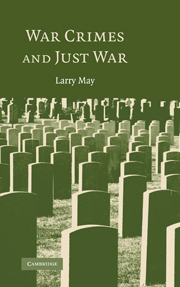Book contents
- Frontmatter
- Contents
- Acknowledgments
- War Crimes and Just War
- 1 Introduction: Justifying War but Restricting Tactics
- PART A A PHILOSOPHICAL GROUNDINGS
- PART B PROBLEMS IN IDENTIFYING WAR CRIMES
- 5 Killing Naked Soldiers: Combatants and Noncombatants
- 6 Shooting Poisoned Arrows: Banned and Accepted Weapons
- 7 Torturing Prisoners of War: Normal and Confined Soldiers
- PART C NORMATIVE PRINCIPLES
- PART D PROSECUTING WAR CRIMES
- Bibliography
- Index
6 - Shooting Poisoned Arrows: Banned and Accepted Weapons
Published online by Cambridge University Press: 05 June 2012
- Frontmatter
- Contents
- Acknowledgments
- War Crimes and Just War
- 1 Introduction: Justifying War but Restricting Tactics
- PART A A PHILOSOPHICAL GROUNDINGS
- PART B PROBLEMS IN IDENTIFYING WAR CRIMES
- 5 Killing Naked Soldiers: Combatants and Noncombatants
- 6 Shooting Poisoned Arrows: Banned and Accepted Weapons
- 7 Torturing Prisoners of War: Normal and Confined Soldiers
- PART C NORMATIVE PRINCIPLES
- PART D PROSECUTING WAR CRIMES
- Bibliography
- Index
Summary
Since the Nuremberg trials, it has become common to separate international criminal law into three divisions where war crimes were one of the three main categories of crime, along with crimes against humanity, and crimes against peace. War crimes are violations of the rules of war, and the rules of war extend back in time for centuries. For example, almost since wars were first fought, there has been a complete ban on the use of poisons during war. The main reason seems to be that such tactics were thought to be inhumane or dishonorable in that they were unfair or caused unnecessary suffering, even when they otherwise appeared to be necessary for achieving a certain military objective. The area of international criminal law that we are investigating is often called “Humanitarian Law,” because it concerns the violations of what is thought to be humane treatment during war. In this chapter I will explore the idea of inhumane treatment in war by reference to the use of poisoned weapons, such as chemicals and other weapons of mass destruction. I ask whether the idea of humane treatment can justify an absolute prohibition on poisons in war.
- Type
- Chapter
- Information
- War Crimes and Just War , pp. 118 - 139Publisher: Cambridge University PressPrint publication year: 2007



